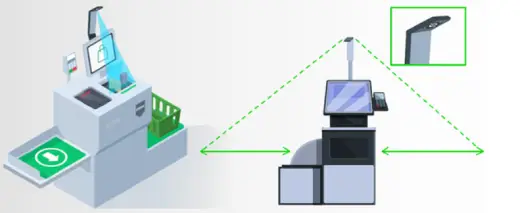However, this shift towards automation has brought new challenges for retailers, particularly in loss prevention. Retailers face significant issues with shrinkage, which includes theft, fraud, and errors during the checkout process.
The growing challenge of retail shrinkage
According to the National Retail Federation (NRF), the average shrink rate increased to 1.6% in FY 2022, representing $112.1 billion in losses. Additionally, in 2023, retailers lost approximately $121.6 billion to retail theft, indicating a significant and ongoing issue. This upward trend highlights the urgent need for effective loss prevention strategies. With the rise of AI and vision-based systems, retailers can now tackle these issues more effectively, ensuring both operational efficiency and customer satisfaction.
Common causes of retail loss and shrinkage at self-checkouts
Missed scans
Intentionally or accidentally, missed scans lead to inventory and revenue discrepancies. This can cause stock-outs or overstock situations, affecting sales data analysis and leading to misguided business decisions.
Barcode or ticket switching
Shoppers swap barcodes to pay less, causing pricing errors and revenue loss. This fraudulent activity is challenging to detect and, if left unchecked, impacts profit margins.
Incomplete transactions
Customers sometimes leave without completing payment or overlook items in the basket, resulting in inventory shrinkage and revenue losses.
How AI-based loss prevention systems can solve it
AI and machine learning have become pivotal in addressing these issues by providing real-time monitoring and advanced analytics. Here’s how AI is transforming retail loss prevention:
Real-time monitoring and insights
AI systems offer unprecedented levels of insight into store operations. They can detect suspicious behaviour and potential theft in real time, allowing for immediate action. These systems analyse patterns that human analysts might miss, providing a comprehensive view of store activities.
Enhanced security measures
AI enhances traditional security systems by integrating with smart cameras and video analytics. These technologies can recognise suspicious activity, monitor movement patterns, and interface with point-of-sale (POS) systems to prevent fraud and theft.
Predictive analytics
AI can analyse past incidents of theft and other losses to identify patterns and predict future occurrences. This allows retailers to develop more effective loss prevention strategies and optimise security protocols.
Automated alerts
When the system detects unusual behaviour, it can automatically alert store personnel, enabling quick responses to prevent theft or fraud.

The role of cameras in AI-based loss prevention systems
Cameras are at the core of effective AI-based loss prevention systems. Their features play a crucial role in ensuring high accuracy and reliability. Key features include:
High resolution and dynamic range
High-resolution cameras capture detailed images, essential for detecting small product labels and facial features. High Dynamic Range (HDR) ensures clear imaging in various lighting conditions. These features are crucial for identifying theft and ensuring accurate monitoring.
Customised lens options
Different retail environments require varied lens configurations. Wide-angle lenses provide broad coverage, while zoom lenses focus on specific areas. Custom lens options ensure comprehensive surveillance across the store, making it easier to monitor large areas and detect suspicious activities.
Multiple connectivity options
Cameras supporting interfaces such as PoE (Power over Ethernet), USB, Ethernet, and GMSL (Gigabit Multimedia Serial Link) can integrate seamlessly with existing retail infrastructure. This versatility of interfaces simplifies installation and maintenance, making the system more robust and adaptable to different environments.
Compact and durable design
Cameras need to be compact and durable to withstand different retail environments. This ensures continuous operation and reliability, reducing downtime and maintenance costs.
AI and Cloud support
Access to AI model training and cloud management services enhances the system’s capability to handle complex loss prevention tasks. Cloud support ensures that the AI algorithms are continuously updated and refined, improving their effectiveness over time. This feature also allows for remote monitoring and management, adding an extra layer of convenience and efficiency.
Conclusion
AI is revolutionising retail loss prevention by providing real-time insights and enhancing traditional security measures. As retailers continue to invest in AI infrastructure, the potential for reducing shrinkage and improving operational efficiency becomes increasingly attainable. By leveraging advanced camera technologies in partnership with AI solutions and retail analytics providers, retailers not only protect their assets but also enhance the overall shopping experience for customers.
Original article source:
FAQ
- How do AI-driven embedded vision cameras enhance self-checkout loss prevention?
AI-driven cameras use machine learning algorithms to analyze video feeds in real-time, identifying suspicious activities such as item concealment or incorrect scanning. This helps in preventing theft and ensuring accurate transactions.
- What types of AI algorithms are used in these cameras?
These cameras typically employ algorithms for object detection, image classification, and anomaly detection. Techniques like convolutional neural networks (CNNs) and other deep learning models are common for recognizing and tracking items.
- Can AI-driven cameras distinguish between different types of items?
Yes, advanced AI systems can differentiate between various items based on their shape, size, and other visual attributes. This capability is crucial for verifying that items scanned at checkout match the items in the shopper’s cart.
- How do these cameras handle false positives?
AI systems are trained to minimize false positives by learning from a wide range of scenarios. Continuous training and refinement of the algorithms help improve accuracy and reduce the likelihood of misidentifying legitimate transactions as suspicious.
- What are the privacy concerns associated with using these cameras?
Privacy concerns include the potential for surveillance and misuse of collected data. It’s important for retailers to ensure that AI-driven cameras comply with privacy regulations and that data is handled securely and responsibly.
- How do these systems integrate with existing checkout infrastructure?
AI-driven cameras are designed to integrate seamlessly with existing self-checkout systems, providing real-time monitoring and alerting without requiring significant changes to the checkout hardware or software.
- What are the costs associated with implementing AI-driven vision cameras?
Costs can vary widely depending on the complexity of the system, the number of cameras needed, and the level of integration required. While initial investment might be high, the potential reduction in theft and improved loss prevention can offer significant long-term savings.
